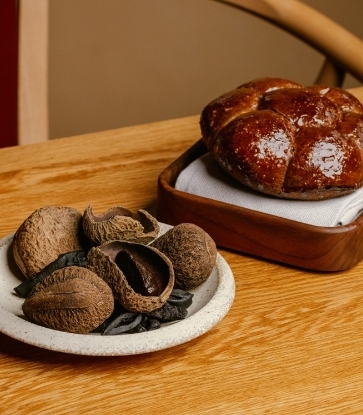For Konstantino Blokbergen, owner of Firebake — Woodfired Bakehouse & Restaurant, his very first loaf of crusty sourdough was born from a starter he made in his very own home.
"It all started three to four years ago with my mixing of the same amount of water and flour (wholemeal and white mix). Although it was more experimental at first, the speed at which my starter became active fascinated me and interested me to continue daily feeds frequently," says Blokbergen.
He continues: "The way the mild sourness and fruity smell from my starter became more distinguished through time motivated me to experiment with few other starters, all made of different flours such as rye, buckwheat and cornmeal."
SEE ALSO: Meet the couple behind The Bakery By Woodlands Sourdough

The ingredients to make a good loaf of bread might seem simple — just yeast, flour, water and salt — but the Swiss-born shares that commercial breads these days are packed with over 20 ingredients, most of which are preservatives and non-natural.
"I have always loved bread and the smell of freshly baked bread is something I never get bored of! Starting Firebake was also to reconnect with bread memories from my childhood where bread took almost 24 hours to be made and contained (only) four key ingredients," says Blokbergen.
Once the initial combination of flour and water is done, a starter needs to be maintained with good wild yeast activity by refreshing it daily; some bakers do it once or twice daily. Though the mix can be left in the fridge for a few weeks if no baking is done, Blokbergen recommends not leaving a starter in there for anything longer than two to three months without refreshing it with more flour and water.
To be sure, getting started might be easy, but keeping a sourdough starter going is the tough bit. Imagine it to be a bit like feeding a pet; stay consistent with the daily timing of your feeding cycles.

If you are planning to place your starter in the fridge for a longer storage time, another important step is to feed the starter right before
you store it in the fridge for longer time; this will help you get faster results when taking out of the fridge for your next bake."
Keep it alive
And don't panic too much if your starter seems less than lively, either. A good sign to assess whether your starter can still be used after a bout of accidental neglect is to brave up and take a good whiff. A basic rule of thumb: if you don’t dare tasting it yourself due to its foul smell, then it's time to throw it out and start all over.
"It is good practice to revive an old starter at least 3 days before starting to bake again. In the case of revival, you will need to first remove any hooch and eventual mold present on the surface of the old starter," says Blokbergen.
He continues: "To do that, I usually pour away the hooch and then 'rinse' the surface of the old starter by pouring a bit of fresh filtered water over it, and then swirling the water around in the jar before pouring it away. This process usually removes most of the old starter crust and allows you to safely reach with a spoon the layer of starter located at the bottom of the jar, which is the part to be used for the first revival feed of flour and water."














